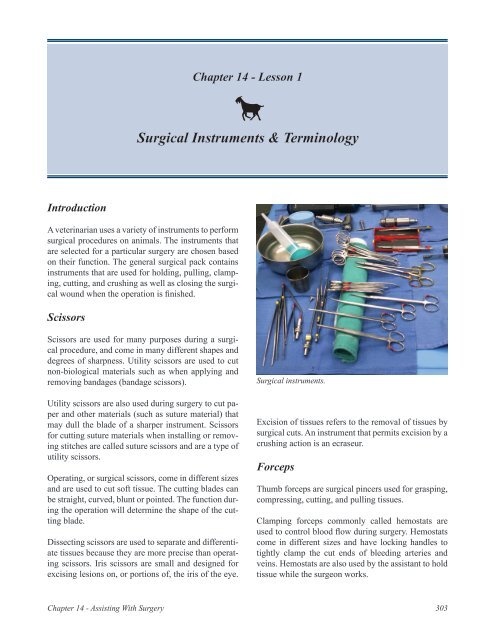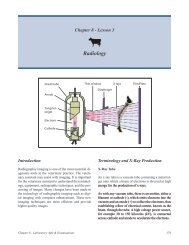Chapter 14 - Lesson 1 Surgical Instruments & Terminology
Chapter 14 - Lesson 1 Surgical Instruments & Terminology
Chapter 14 - Lesson 1 Surgical Instruments & Terminology
Create successful ePaper yourself
Turn your PDF publications into a flip-book with our unique Google optimized e-Paper software.
Introduction<br />
<strong>Chapter</strong> <strong>14</strong> - <strong>Lesson</strong> 1<br />
<strong>Surgical</strong> <strong>Instruments</strong> & <strong>Terminology</strong><br />
A veterinarian uses a variety of instruments to perform<br />
surgical procedures on animals. The instruments that<br />
are selected for a particular surgery are chosen based<br />
on their function. The general surgical pack contains<br />
instruments that are used for holding, pulling, clamping,<br />
cutting, and crushing as well as closing the surgical<br />
wound when the operation is finished.<br />
Scissors<br />
Scissors are used for many purposes during a surgical<br />
procedure, and come in many different shapes and<br />
degrees of sharpness. Utility scissors are used to cut<br />
non-biological materials such as when applying and<br />
removing bandages (bandage scissors).<br />
Utility scissors are also used during surgery to cut paper<br />
and other materials (such as suture material) that<br />
may dull the blade of a sharper instrument. Scissors<br />
for cutting suture materials when installing or removing<br />
stitches are called suture scissors and are a type of<br />
utility scissors.<br />
Operating, or surgical scissors, come in different sizes<br />
and are used to cut soft tissue. The cutting blades can<br />
be straight, curved, blunt or pointed. The function during<br />
the operation will determine the shape of the cutting<br />
blade.<br />
Dissecting scissors are used to separate and differentiate<br />
tissues because they are more precise than operating<br />
scissors. Iris scissors are small and designed for<br />
excising lesions on, or portions of, the iris of the eye.<br />
<strong>Surgical</strong> instruments.<br />
Excision of tissues refers to the removal of tissues by<br />
surgical cuts. An instrument that permits excision by a<br />
crushing action is an ecraseur.<br />
Forceps<br />
Thumb forceps are surgical pincers used for grasping,<br />
compressing, cutting, and pulling tissues.<br />
Clamping forceps commonly called hemostats are<br />
used to control blood flow during surgery. Hemostats<br />
come in different sizes and have locking handles to<br />
tightly clamp the cut ends of bleeding arteries and<br />
veins. Hemostats are also used by the assistant to hold<br />
tissue while the surgeon works.<br />
<strong>Chapter</strong> <strong>14</strong> - Assisting With Surgery 303
Needle holders are locking forceps that are used to<br />
hold a suture needle when installing stitches or closing<br />
a surgical incision.<br />
Scalpels<br />
A surgical cut made into a tissue or organ is called an<br />
incision. <strong>Surgical</strong> scalpels are used to make incisions<br />
and for excision of tissues or organs.<br />
A surgical scalpel is a very sharp knife. Often the handle<br />
and the blade are packaged separately and assembled<br />
by the surgeon at the beginning of the operation;<br />
this maintains the sterile field. In some cases, the surgical<br />
scalpel is a single unit. Replaceable blades and<br />
handles come in different sizes and styles so the surgeon<br />
can perform operations on all types of animals.<br />
A dissecting scalpel or tenotome is for fine dissection<br />
and cutting or dividing tendons.<br />
Tubes<br />
Veterinarians commonly use lengths of tubing during<br />
operations and as part of wound healing. A tube that<br />
is inserted into a body cavity for drainage of fluid is<br />
called a drain.<br />
A cannula is a drain that is used to release build-ups<br />
of fluid or gas from animals. A trocar is a sharp stylet<br />
(or needle) enclosed in the cannula that is inserted<br />
through the wall of the body cavity. When the stylet<br />
(trochar) is withdrawn, the fluid or gas can drain<br />
through the cannula.<br />
Catheters are tubes made of either metal or rubber that<br />
are inserted into body structures, permitting the passage<br />
of fluids into or out of the body through anatomic<br />
orifices or incisions during and after an operation.<br />
Body structures that are commonly catheterized are<br />
the urinary bladder and blood vessels.<br />
References<br />
Hurov, L. (1978). Handbook of veterinary surgical<br />
instruments and glossary of surgical terms.<br />
Philadelphia, PA: Saunders.<br />
Miller, C. W. (2003). Bandages and drains. In: Textbook<br />
of small animal surgery (pp. 244-249).<br />
Philadelphia, PA: Saunders.<br />
304<br />
Questions<br />
1. Describe the function of the following surgical<br />
instruments:<br />
a. Thumb forceps<br />
b. Hemostats<br />
c. Operating scissors<br />
d. Ecraseur<br />
e. Scalpel<br />
Activity<br />
Bandage scissors, thumb forceps,<br />
hemostats, and scalpel.<br />
1. Under the supervision of a veterinarian, handle<br />
various surgical instruments in the different surgical<br />
packs. Observe the actions and purposes of<br />
each instrument.<br />
<strong>Chapter</strong> <strong>14</strong> - Assisting With Surgery




